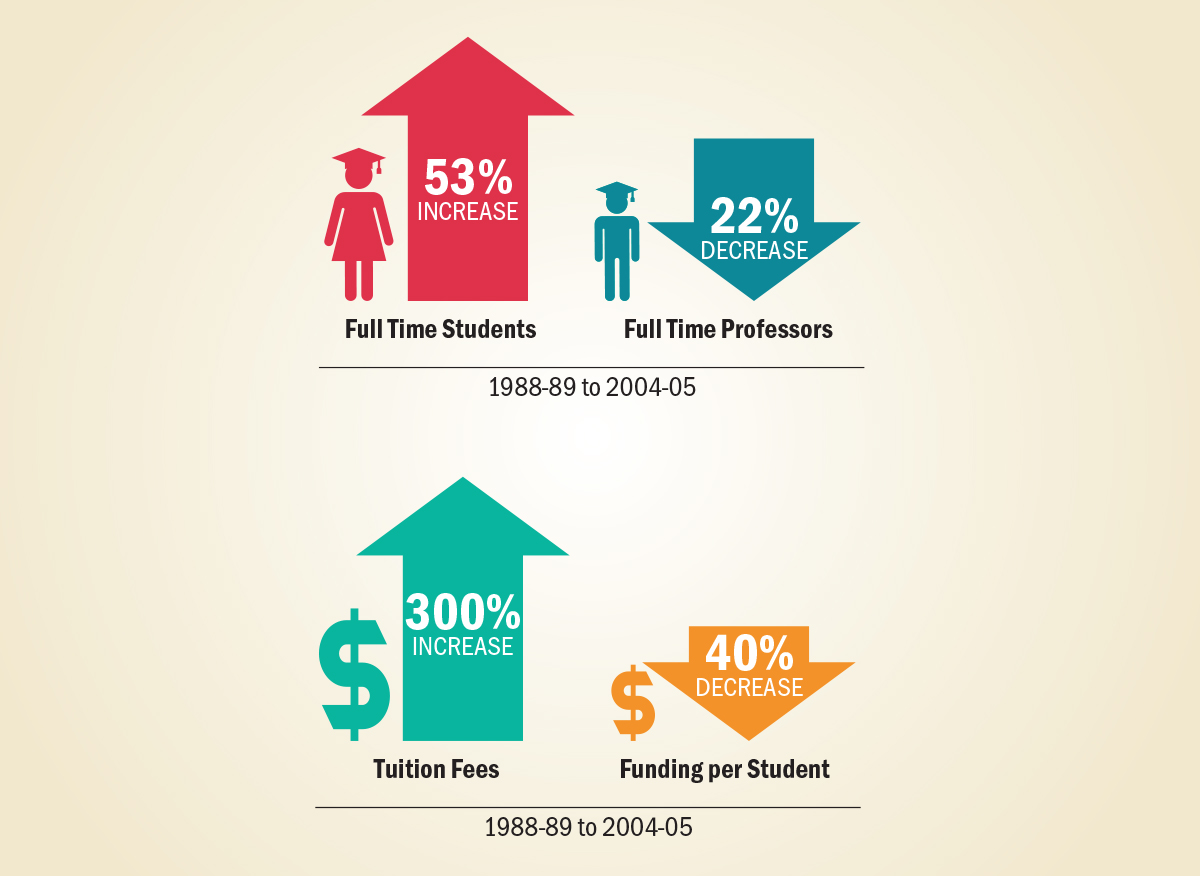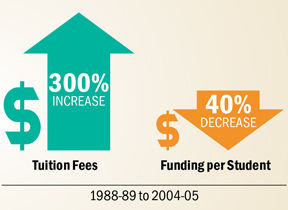
A tale of two mandates
Last September, the Ontario Public Service Employees Union (OPSEU) Colleges of Applied Arts and Technology—Academic (CAAT-A) division organized a campaign to connect with faculty and investigate the state of education at Ontario’s community colleges. As part of the campaign, I traveled to all 24 colleges in the province to discuss the experiences and perceptions of professors, counselors, and librarians. The impetus behind the project came from a pervasive sense that college faculty are facing unprecedented challenges to their working conditions and to their ability to deliver high-quality education.
The challenges being faced by faculty speak directly to the mandate of Ontario’s postsecondary education system, and in particular to the role played by community colleges. The original mandate of the CAATs was laid out in their founding legislation, introduced in 1965. The colleges were initially seen as providing access to postsecondary education for groups who wouldn’t normally attend university due to socioeconomic barriers. The mandate also closely linked each college with its surrounding community, and ensured that colleges would be responsive to local educational, job training, and community development needs.
Community colleges were structured around a progressive vision that reflected government and social priorities of the time and saw education as a tool for promoting social justice and social change. However, as public institutions, the CAATs have been subject to shifts in government priorities in the years since their founding.
As governments in the 1980s and 1990s embraced a neoliberal ideology, a competing vision of the colleges emerged. This new vision emphasized corporate organization, privatization, entrepreneurship, and inter-institutional competition. On today’s college and university campuses, the two visions are locked in conflict. At stake is whether postsecondary education continues to fulfill a progressive mandate centered on education as a tool for social justice and change, or whether it succumbs to a neoliberal agenda driven by government austerity and private interest.
 The new corporate college
The new corporate college
Effects of the ascendant neoliberal vision have been increasingly apparent in Ontario’s colleges in recent years. This vision has led to decreased government funding, the casualization of the academic workforce, the expansion of online learning, reliance on private service providers, and the erosion of academic freedom. These effects have in turn had an impact on students, manifested in sky-rocketing tuition fees, a crushing student debt burden, increased class sizes, decreased services, and lower-quality education.
Arguably the most direct effect of the neoliberal turn in provincial and federal politics has been the steady decline in government support for Ontario colleges and universities. The election of Brian Mulroney’s Progressive Conservative government in 1984 saw a decline in federal funding to the provinces for health, education, and social services. This led to fiscal crises in the provinces, which struggled to maintain levels of public service delivery. From 1995, Mike Harris’ Progressive Conservative government accelerated the fiscal transformation of Ontario. At both the federal and provincial levels, corporate taxes were slashed along with marginal tax rates for the highest income earners. As a result of these policies, governments lost billions of dollars per year in tax revenue, income inequality steadily increased, and funding for public services steadily declined.
At the time of their founding, approximately 75 per cent of operating funding for the CAATs came from provincial government grants via the Ministry of Colleges and Universities (MCU), and the Ministry of Skills Development (MSD). The next greatest sources of revenue came from federal government purchases of apprenticeship program seats, and from tuition fees paid by students. Tuition originally accounted for between 10 and 15 per cent of operating revenues. This financial situation did not last long. From 1978-79 to 1981-82, government grants fell by 28 per cent. An infusion of new funding came in 1986-87, addressing some of the shortfall, but still leaving the real (inflation-adjusted) level of government funding at 84 per cent of its 1978-79 levels. Since the 1980s there has also been a steady decline in federal funding for higher education. In 1992-93 federal cash transfers for postsecondary education were 0.41 per cent of GDP. As of 2012-13, they were only 0.20 per cent of GDP—a 50 per cent decrease.
Provincial funding for colleges has continued to decline. The Harris Conservative government in Ontario was instrumental in these changes, cutting $7 billion in funding for health, education, and social services. By 2005, Ontario colleges were getting 40 per cent less funding per student than they did in 1988-89.
Tuition fees tripled over the same 15 year period. Today, funding per full-time postsecondary student in Ontario is the lowest among all the provinces, and government grants make up less than 50 per cent of college revenues. Tuition fees currently account for 33 per cent of the operating revenue of Ontario colleges, a 300 per cent increase from 1967. In essence, the cost burden of postsecondary education has shifted from tax revenue paid by the wealthiest Canadians and by corporations, to tuition fees paid by students.
The consequences of declining funding for the colleges should be familiar to any university observer. With less money flowing in, college management has been relying heavily on less-expensive part-time faculty, while also increasing class sizes. In the 15 year period from 1988-89 to 2004-05, full-time student enrolment in the colleges increased 53 per cent, while the number of full-time faculty decreased by 22 per cent. The decrease in full-time professors, counselors, and librarians means that two thirds of college faculty are now part-time. Of the 24 colleges, all but three have not come close to recovering their highest complement of full-time faculty, and most are substantially below this number.
While full-time faculty have become scarce within the system, the number of full-time administrators has been rapidly expanding. Between 1995-96 and 2011-12, the number of college administrative staff increased by 55 per cent. This increase in administration reflects sweeping institutional transformations that occurred in the face of privatization and increased competition. Under the Harris government, college recruitment strategies changed. Originally the CAATs recruited students from their regional catchment areas, and thus each institution had a defined territory from which to draw students. Under the Harris Conservatives, the catchment areas were abolished, and colleges and universities were encouraged to compete for students in a province-wide, deregulated “educational marketplace.” In keeping with the Harris government’s neoliberal ideology, other changes were made that increased the competitive nature of the postsecondary education environment. For example, the CAATs were given the authority to grant degrees and were encouraged to partner with universities on collaborative degree programs.
The competitive pressure to deliver education with less funding has also seen the privatization of college programs. Today a number of government-funded community colleges have formed partnerships with private, for-profit campuses. The subsidiary campuses operate under a licensing agreement with the publicly funded college, in which the name, branding, curriculum, and credentials are purchased by the private institution. The private campus instructors are not Ontario college faculty or OPSEU members, and their credentials and training are unregulated. Instructors at private campuses are paid substantially less than Ontario college faculty, and they have no union protection and little job security. In addition, the private campuses overwhelmingly target international students. Tuition fees for these students are unregulated, making them attractive revenue generators. Through the combination of lower staffing costs, lower building costs, and lucrative international student fees, private campuses have become an important revenue stream for several publicly funded colleges. The private college campuses are generally in different communities, with Cambrian College partnering with Hansen College in Brampton and Toronto; Mohawk College partnering with Pures College in Scarborough; and St. Lawrence College partnering with Alpha International Academy in Toronto.
Another outcome of cost-cutting pressure in the colleges has been the proliferation of online learning. In the 1995-96 school year, seven northern colleges created Contact North, a consortium that launched Ontario Learn, a hub for delivering online credit courses. Since its creation, Ontario Learn has been expanding its offerings. In 2000-01 there were 285 online courses with 11,314 registrants. By 2012-13 this had climbed to 1,115 course offerings with 69,838 students enrolled. Online learning can be a useful option for many students. However, colleges have pursued online learning as a means to cut costs, not improve the educational experience. The proliferation of online courses has also been a way for colleges to transfer work away from full-time professors. Most online instructors are part-time, and the majority of their work involves delivering courses that would otherwise be taught in regular campus settings. Using the standard workload formula currently contained in the college faculty collective agreement, OPSEU has calculated that the number of courses being taught through Ontario Learn is roughly the equivalent of 500 full-time faculty jobs.
In 2012, then-Minister of Training, Colleges and Universities Glen Murray released Strengthening Ontario’s Centres of Creativity, Innovation and Knowledge. This document argued for the need to re-organize postsecondary education through a process of differentiation that would eliminate supposed duplication of courses, programs, and credentials across the college and university sectors. The motivation behind increased differentiation was to control costs and a key strategy outlined in the document was to use online learning to deliver core courses to students at multiple institutions.
The government and administrative push for online course delivery is having a profound impact on colleges. At Mohawk, for example, the online mandate has been enforced institution-wide, and has completely superseded faculty’s ability to determine the form and content of their courses. It has also impaired the ability of students to access delivery methods that meet their diverse learning needs. College management has decreed that every lecture-based course must eliminate one hour of class time and replace it with one hour of online content. This “hybrid” or “blended” model of course delivery has met significant pedagogical criticism from faculty, and has triggered an outpouring of student anger and dissatisfaction.
For college faculty, the widespread use of online learning is a direct attack on academic freedom. Long a source of contention within the colleges, academic freedom has historically had a de facto existence in most institutions, while not obtaining de jure status in the faculty collective agreement. Under current cost-cutting and privatization pressures, the formerly collegial environment that saw college professors control academic issues has given way to an autocratic management regime that denies faculty control at every turn.
In the colleges today, managers are increasingly changing faculty grades, imposing textbooks, mandating publisher-developed “courses in a can” for faculty to teach, determining course evaluation methods, and dictating course delivery methods. With no protection for academic freedom in the collective agreement, faculty have little grounds to contest these impositions, or to criticize management decisions that are clearly detrimental to academic quality and student success. Additionally, with no academic freedom, faculty have no grounds to contest the appropriation and sale of their intellectual property. Faculty-developed online courses become the exclusive property of the college. Faculty curriculum can be sold to private institutions, who deliver courses and programs in direct competition with the faculty who first designed them. With no academic freedom, college faculty are essentially being directed to work themselves right out of a job.
Reclaiming education as a public good
What college faculty have increasingly realized is that the cost-cutting and privatizing pressures they now face are part of a wider assault on postsecondary education itself. We know that our colleagues in Ontario universities are enduring the same process of differentiation, through which courses, programs, departments and institutions must engage in economic competition for their very survival. We know that sessional and contract appointments are swelling the ranks of university faculty, and that academic freedom is being slowly dismantled through casualization and budget pressures. We also realize that students enrolled in both colleges and universities are bearing the brunt of neoliberal adjustments, as they pay steadily greater amounts for steadily diminishing educational returns. We all have a shared interest in the integrity of postsecondary education, and if the system is to be reclaimed in the name of education, then this shared interest must catalyze into shared action.
Of necessity, our action will involve local struggles within each institution, and within each association and union local. These are important. However, faculty and students must also engage the larger forces that determine government priorities, and that constrain local realities. The neoliberal ideology that now ravages our colleges and universities has penetrated every aspect of Canadian society—replacing the notions of collective good, public service, and government stewardship with an individualistic market fundamentalism that is as dogmatic as it is, ultimately, irrational. In order to combat the effects of this ideology within colleges and universities, we need to shift the political culture and the legislation that perpetuates it. This will involve coalition-building between faculty and students at all postsecondary institutions, and political action at both provincial and federal levels.
Ultimately, our political struggle must help connect the dots—for our members and for the public at large—between government policy and institutional realities. Tax breaks for the rich and corporations lead to gutted government revenues and high income inequality. Budget deficits caused by missing tax revenue are then used as a pretext to dismantle social infrastructure. Public services are bled to the point that they are too weak to resist private intrusion. Public service professionals—protected by unions and possessing pensions and decent salaries—are eliminated. Finally, the public good of education—long a source of critical reflection and progressive change—instead becomes a mere credential mill, and a lucrative source of “knowledge capital”. This is the logic we are now facing, and this is the future that awaits us should the corporate mandate prevail. The outcome of this struggle is not yet decided, but our failure to act decisively will only see us slide further down the neoliberal slope. AM










